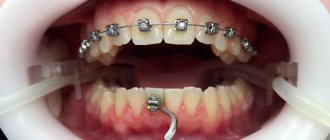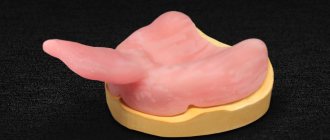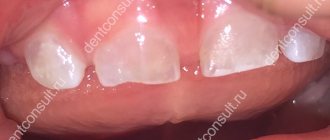Sooner or later, almost all people face the need to have dental prosthetics. Of course, it would be better if such a moment came as late as possible, but if problems with the dentition have arisen, they need to be resolved quickly so as not to cause irreparable harm to one’s own health. What dentures are best to put in if it’s time to “surrender” to the hands of an orthopedic dentist? To make a good choice, you need to know what dentures are in general and in what cases they are usually used.
Review of modern technologies that allow you to insert teeth
Just 30 years ago, there was only one way to replace lost teeth—prosthetics, and patients were offered crowns made of heavy and unesthetic materials—various metal alloys. And no one was embarrassed by the sight of metal teeth in the smile area. Nowadays, you can insert teeth in such a way that no stranger will even guess that you have a crown or prosthesis in your mouth, and not your natural teeth - to do this, just choose crowns made of metal-ceramics, ceramics or zirconium dioxide.
Teeth can be replaced using dentures or implantation. Both technologies are universal and applicable both for single restorations (in the absence of 1-4 teeth) and for completely toothless jaws.
It is important to understand that implantation does not exclude the stage of prosthetics, however, the crown in this case is not placed on the supporting tooth, but on the abutment of the implant implanted into the jaw bone.
How can you insert teeth in your case? The answer to this question will depend on how many teeth you are missing:
1. If you have teeth, but are severely damaged, you may be offered prosthetic crowns or immediate implantation.
2. If only one tooth is missing in a row, it can be inserted either by installing a denture (bridge) or by implantation. The latter method will be preferable, as it will allow the tooth to be inserted without affecting healthy teeth. The implanted implant will serve as a support for the crown.
3. If a large number of teeth, or even all teeth, are missing in the rows, they can be inserted using removable dentures or dentures on implants.
IMPORTANT: On the Internet you can find many reviews from people who decided to have teeth inserted and subsequently encountered various complications - from pain to prosthesis breakage or implant rejection. There is only one reason for such reviews - poor quality treatment. Therefore, if you decide to have teeth inserted, do not be lazy to spend time carefully choosing the clinic where you will have your teeth inserted.
Both during prosthetics and implantation, you may be offered to insert teeth with different types of dentures and crowns. Let's look at the features, pros and cons of all possible options.
Which is the best method to choose?
There is an alternative to dental prosthetics using implants, and for those who, due to contraindications or other reasons, cannot undergo implantation, this is a real salvation. And in each individual case, a method is selected based on specific conditions, the nature of the clinical picture, the requirements and capabilities of the patient.
But still, when choosing, it is necessary to take into account that implantation today is essentially the only method that provides complete restoration of the functionality of the dental system, including stopping bone atrophy. Perhaps a full-fledged alternative to dental implantation will appear in the near future, but for now it does not exist - all methods of prosthetics without implantation have disadvantages and do not ensure the transfer of chewing load to the bone, which causes degradation of the jawbone, gradual displacement and destruction of the remaining teeth.
Insert teeth with metal-ceramic crowns
You can inexpensively replace teeth with metal-ceramic crowns. Such dental prostheses have a metal base and are covered with a layer of ceramic mass on top. This is done so that the finished crown has a natural and aesthetic appearance.
Metal-ceramic crowns are used in both traditional prosthetics and implantation, however, if you need to insert a front tooth, this option of dentures is not suitable. The fact is that the metal from which the base of the crown is made oxidizes over time and this reaction can cause the gums to appear blue in the area where the crown is installed. This cyanosis will be clearly visible when smiling or talking, which of course will affect the level of aesthetics.
If you want to see what a smile will look like if you replace your teeth with metal-ceramic crowns, look at the photos we publish below.
Insert ceramic teeth
Inserting ceramic teeth will be the right decision if you need to restore your front teeth, which are clearly visible when communicating with people around you. But for the restoration of chewing teeth, ceramic crowns are not suitable: ceramics is a fairly fragile material and a crown made from it may not withstand the heavy load that is constantly placed on the chewing teeth when chewing food.
The high aesthetics of ceramic crowns determines the expensive prices for this type of orthopedic structures. But the patient gets a beautiful and natural smile: you can also evaluate the results of dental restoration with ceramic crowns from the photos that we have posted below. Ceramic crowns can be placed on both the abutment tooth and the implant.
Examples of work “Before” and “After”
Restoration of chewing teeth - basal implantation (March 2012)
Case: absence of chewing teeth in the lower jaw.
Basal implantation of posterior teeth
Case: absence of all chewing teeth in the lower jaw.
Basal implantation of posterior teeth
Case: the patient complained of the inconvenience of a removable denture in the area of the chewing teeth in the lower jaw.
Restoration of chewing teeth with ROOTT implants
Case: absence of three chewing teeth in the upper jaw Work: three one-stage ROOTT implants and a metal-plastic bridge with three crowns were installed.
How to insert a tooth if there is no root?
If you have had a tooth removed, you can insert it using implantation, and this can be done immediately after the extraction procedure - using the method of one-step implantation. With this method of tooth restoration, implants are implanted directly into the socket of the extracted tooth and then a temporary prosthesis is placed on them. Simultaneous implantation will allow you to insert a tooth and not walk with an unpleasant dentition defect. The doctor will install a permanent crown on the implant abutment after it has fused with the bone - this usually takes 3-4 months.
Implantation is recognized as the most reliable and durable way to restore extracted and lost teeth, but it is not always possible to replace teeth with it - there is a fairly wide range of contraindications for this surgical operation.
Acrylic dentures for edentulous patients
Removable plate structures made of acrylic plastic are the most affordable method of dental prosthetics to replace an entire row of teeth. They are able to completely restore an extensive defect, evenly distributing the chewing load on the gums.
Fixation on a toothless jaw is carried out due to the fact that the plastic base exactly repeats the relief of the mucous membrane and firmly adheres to it. When put on, a closing valve is naturally created, which does not allow the product to move. The stability of the acrylic plate is also ensured by retention - retention due to the anatomical structure of the prosthetic bed. In a number of clinical cases, it is impossible to create conditions for natural reliable fixation due to age-related changes in the jaws (atrophy), so additional devices are used. The product can be attached using implants or mini-implants, which are implanted into the bone and are equipped with a lock or push-button fastening onto which the prosthesis is placed. Such acrylic structures are conditionally removable.
Caring for removable acrylic products for edentulous patients is simple and consists of washing them after each meal and systematic cleaning with special hygiene products at least once a day. If fixing gels or creams are used when wearing it, it is not necessary to remove the structure after eating, just rinse your mouth with water. Daily hygienic treatment consists of cleaning with a soft bristle brush and a paste without abrasive particles.
At the Dentistry Academy Dent, located in the south-west of Moscow, prosthetics for large defects or edentia are carried out by a doctor with 22 years of experience in dental practice. Experience, knowledge of the most effective methods of orthopedic treatment and an individual approach at each stage allow us to achieve lasting positive results. When visiting the clinic, each patient receives detailed professional advice on all issues of interest and the necessary recommendations.
How are dental implants inserted?
Implantation, in order to insert teeth, can be carried out in different ways: according to a one-stage or two-stage protocol. But its essence will always boil down to the following: in order to insert a lost tooth, the doctor will implant a special structure in the patient’s jaw - an implant, on which he will subsequently install a crown or prosthesis.
Until the stage of permanent prosthetics, you will walk with a temporary prosthesis, which is placed during one-stage implantation immediately after implantation. In two-stage implantation, immediate dentures are used to mask dentition defects.
A permanent crown or prosthesis is placed on the implant only after it has completely fused with the natural bone tissue of the jaw. Crowns for installation on an implant can be made from any material: for the restoration of front teeth, ceramic crowns are most often used, for the restoration of chewing units - products made of zirconium and metal-ceramics.
Which implantation technology should I choose to insert teeth? It is impossible to give any absentee recommendations on this matter. You need to visit the clinic, undergo an examination and diagnosis, and only after that the implantologist will offer you the optimal implantation method.
Bridges
Indications for the use of a bridge-type prosthesis are medium-length defects limited on both sides. Before prosthetics, photographs are taken to study periodontal tissue, the condition of which is very important for choosing the correct method of orthopedic treatment. In some clinical cases, treatment of carious lesions and their complications may be required. After anesthesia, grinding is carried out, an impression is taken and sent to the laboratory. After testing, the finished structure is firmly fixed with orthopedic cement.
Depending on what material the bridge crowns are made of, the following types are distinguished:
- metal-ceramic (combined);
- metal-free (porcelain, ceramic, zirconium);
- plastic.
The plastic type of crowns does not have sufficient strength and aesthetics, therefore they are most often used in temporary (provisional) products. Metal-ceramics are very resistant to damage, can withstand heavy loads and are well suited for recreating the posterior part of the teeth. The use of metal-ceramic crowns to replace incisors and fangs that are visible when smiling can give an unaesthetic result. Zirconium crowns are the most durable and natural, with the help of which they effectively restore both the front row of teeth, where aesthetics are important, and the side teeth, which experience high chewing pressure.
Advantages of bridge products:
- the possibility of replacing several adjacent teeth;
- durability: their service life reaches 10 years;
- low cost compared to implantation systems.
A relative disadvantage of a bridge is the need to grind down healthy teeth. If the patient wishes to keep the remaining teeth intact and do without preparation, it is possible to install an implant as the main support.
If you need to insert a tooth after it has been removed
The best solution to insert one tooth is a one-time implantation, but a tooth can only be inserted if too much time has not passed since its removal. To firmly fix the implant in the bone, the jaw bone tissue must be dense and have a certain height. But the longer a tooth is missing, the more the bone thins and dries out. Therefore, if you had a tooth removed several years ago, you can have it replaced either with prosthetics or classical implantation.
When implantation is not possible
| Absolute contraindications | Relative restrictions* |
| Pathologies of immunity | Pregnancy and lactation |
| Severe systemic infectious diseases | Acute viral infections |
| Malignant processes | Exacerbation of chronic pathologies |
| Autoimmune diseases | After a heart attack or stroke |
| Age up to 18 years | Dental diseases on adjacent teeth (pulpitis, caries) |
| Pathologies of bone tissue | Periodontal problems (periodontitis in the acute phase) |
| Mental disorders | Blood clotting disorders |
* These contraindications are considered relative; after adjusting the health status, it becomes possible to install an implant.
How much does it cost to get teeth inserted?
Teeth can be inserted in different ways and using different crowns or dentures, so the price of the service can be very different. Below we publish prices for services for restoring damaged or lost teeth, which are offered by our dental clinic in Moscow - “Aesthetica”!
If you want to insert teeth so that the restoration result is both beautiful and high-quality, come to our dentistry! We have created all the conditions for high-quality, painless dental restoration in the most difficult cases!










